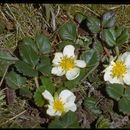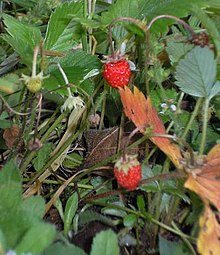Associations
provided by BioImages, the virtual fieldguide, UK
Foodplant / miner
solitary larva of Agromyza potentillae mines leaf of Fragaria
Foodplant / miner
larva of Agromyza sulfuriceps mines leaf of Fragaria
Other: major host/prey
Foodplant / open feeder
larva of Allantus calceatus grazes on leaf of Fragaria
Foodplant / open feeder
larva of Allantus cinctus grazes on live leaf of Fragaria
Other: major host/prey
Foodplant / open feeder
larva of Allantus cingulatus grazes on leaf of Fragaria
Foodplant / feeds on
larva of Anthonomus rubi feeds on Fragaria
Other: major host/prey
Foodplant / internal feeder
imago of Barypeithes araneiformis feeds within fruit of Fragaria
Foodplant / spinner
caterpillar of Cacoecimorpha pronubana spins live leaf of Fragaria
Other: minor host/prey
Foodplant / open feeder
larva of Cladius difformis grazes on leaf of Fragaria
Foodplant / open feeder
larva of Cladius pectinicornis grazes on leaf of Fragaria
Foodplant / open feeder
larva of Claremontia confusa grazes on leaf of Fragaria
Other: sole host/prey
Foodplant / feeds on
immersed pycnidium of Coniella coelomycetous anamorph of Coniella fragariae feeds on receptacle of Fragaria
Plant / resting place / on
adult of Cryptocephalus labiatus may be found on Fragaria
Remarks: season: 3-11
Foodplant / pathogen
Ditylenchus dipsaci infects and damages live, thickened, often with brown core peduncle of Fragaria
Remarks: season: Spring
Foodplant / open feeder
larva of Empria liturata grazes on leaf of Fragaria
Foodplant / roller
larva of Epichoristodes acerbella rolls live leaf of Fragaria
Other: minor host/prey
Foodplant / pathogen
conidioma of Zythia coelomycetous anamorph of Gnomonia comari infects and damages live stolon of Fragaria
Other: major host/prey
Foodplant / feeds on
Lepyrus capucinus feeds on Fragaria
Foodplant / sap sucker
Macrosiphum euphorbiae sucks sap of live shoot (young) of Fragaria
Foodplant / shot hole causer
colony of Ramularia anamorph of Mycosphaerella fragariae causes shot holes on live leaf of Fragaria
In Great Britain and/or Ireland:
Foodplant / feeds on
Otiorhynchus ovatus feeds on Fragaria
Foodplant / parasite
hypophyllous colony of sporangium of Peronospora fragariae parasitises live leaf of Fragaria
Foodplant / feeds on
pycnidium of Phoma coelomycetous anamorph of Phoma leveillei feeds on Fragaria
Foodplant / parasite
cleistothecium of Podosphaera aphanis parasitises live stolon of Fragaria
Foodplant / open feeder
larva of Priophorus pallipes grazes on leaf of Fragaria
Foodplant / internal feeder
larva of Rhynchites germanicus feeds within decaying stolon of Fragaria
Foodplant / sap sucker
Scolopostethus affinis sucks sap of seed of Fragaria
Other: minor host/prey
Foodplant / spot causer
epiphyllous pycnidium of Stagonospora coelomycetous anamorph of Stagonospora fragariae causes spots on live leaf of Fragaria
Brief Summary
provided by EOL authors
Fragaria is a genus of about 12 species, the strawberries, in the Rosaceae (rose family) native primarily to north temperate regions (North America, Eurasia). The genus includes the garden or pineapple strawberry (F. X ananassa), which is cultivated in temperate and semitropical regions worldwide for its delicious fruit. Wild strawberries of various species are edible and often collected despite their small size, while horticultural varieties have been developed for use as ornamentals and ground cover. Widespread wild strawberry species include F. virginiana, which grows through eastern North America; F. vesca, the alpine strawberry, which has a Eurasian distribution and has now also naturalized in North America; and F. chiloensis, beach strawberry, which occurs from coastal Alaska to California and extends into South America. F. ananassa, the garden strawberry, is a hybrid of F. virginiana and F. chiloensis, although some studies suggest that it may also carry genes from other species. Native to Europe, the musk strawberry (F. moschata) is also cultivated, similarly to the garden strawberry. Fragaria plants are woody (or occasionally herbaceous) perennials that spread vegetatively, by stolons--rooting runners that form new plantlets at the tip--as well as seed; commercial propagation is entirely by the runners. The leaves, which overwinter are alternate (in winter, appearing as a basal rosette) and compound, usually with 3 but occasionally with 5 coarsely toothed leaflets. Flowers have 5 sepals and 5 petals and are generally white, although may be pinkish or reddish in some species and cultivars. The strawberry, which usually ripens to red, is not a true berry botanically, but is a fleshy receptable bearing multiple fruits on the surface—these apparent seeds are actually achenes, small, one-seeded fruits with hard coverings that do not split open (dehisce) when ripe. Strawberries are often eaten as a fresh fruit, famously in strawberry shortcake, and are also processed into ice creams, jams and preserves, mousses, fruit juice, and various baked goods and candies. Strawberries may also be fermented into wine or liqueur (such as the Italian fragoli). In 2010, the worldwide commercial production of strawberries was 4.4 million metric tons (mmt), harvested from around 244,000 hectares. Nearly 10% of the area harvested was in the U.S., but that accounted for more than than 25% of the total (1.3 mmt). Strawberry production is particularly important in California, which produces 88% of the U.S. total, valued at around $2.3 billion annually. The U.S. harvest was more than 5 times that of any other country. Other major producers include Turkey, Spain, Egypt, Korea, and Mexico. Strawberries are particularly susceptible to damage from frost, and became the subject of a famous early field test of releasing genetically engineered organisms into the environment. Research starting in the 1960s had identified a bacterial species, Pseudomonas syringae, that provides nucleation sites for ice crystals to form (the so-called “ice-plus” bacteria). With a single genetic modification, the surface proteins in these bacteria can be altered so that they no longer provide a suitable ice-formation surface. Bacteria altered to have the “ice-minus” gene, developed by the California company, Advanced Genetic Sciences, were tested in a controversial field experiment on strawberries in 1987, in which a bacterial solution was sprayed on the strawberry plants before a frost. Although initial results suggested the modified bacteria did prevent ice formation, concerns about whether releasing these bacteria for commercial application might adversely affect snow and ice formation, with potentially large implications for regional weather patterns, have inhibited widespread use of ice-minus bacteria in strawberry cultivation. (Bailey et al. 1976, California Strawberry Commission 2012, Domoto et al. 2008, FAOSTAT 2012, Flora of China 2012, Nottingham 2003, van Wyk 2005.)
Fragaria: Brief Summary
provided by wikipedia EN
Fragaria (/frəˈɡɛəri.ə/) is a genus of flowering plants in the rose family, Rosaceae, commonly known as strawberries for their edible fruits. There are more than 20 described species and many hybrids and cultivars. The most common strawberries grown commercially are cultivars of the garden strawberry, a hybrid known as Fragaria × ananassa. Strawberries have a taste that varies by cultivar, and ranges from quite sweet to rather tart. Strawberries are an important commercial fruit crop, widely grown in all temperate regions of the world.
- license
- cc-by-sa-3.0
- copyright
- Wikipedia authors and editors




